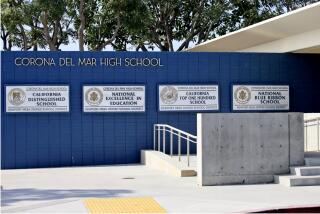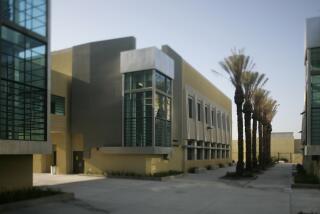Athlete Who Suffered Stroke Will Walk Again, Doctor Says
- Share via
Monday began grimly for the Buena High School football team and Coach Rick Scott.
For all they knew, their friend and teammate, Jeff Larson, would never walk again, paralyzed on his left side by a stroke that doctors say was caused by a neck injury he suffered eight days earlier.
And as Larson, 18, lay strapped to a hospital bed in a neuro-intensive-care unit at UCLA Medical Center, Scott spoke somberly about what was sure to be a tough week as his team prepared to meet rival Oxnard High School on Friday night.
Had he been telling his kids the right thing about trying to play with injuries over his 27 years of coaching?
How would he keep his team focused?
Was his player going to be all right?
By day’s end, Scott had his most pressing question answered.
Larson’s neurosurgeon said that aside from some mild lingering effects from the stroke, the student will eventually regain his ability to walk, talk and use his left arm.
“It’s better news than I could have ever hoped for,” Scott said as he walked across a Buena High courtyard on his way to football practice.
Dr. Paul Vespa, director of the neuro-critical department at UCLA, said Monday that Larson is “80% better” than he was when paramedics brought him in late Saturday night.
Hitting Larson on Saturday as he worked at his job as a ride attendant at Golf N’ Stuff in Ventura, the stroke, Vespa said, was caused by a blood clot that had been growing in Larson’s neck for eight days and eventually cut off the blood supply to the brain.
The clot was apparently caused by a tear in Larson’s right carotid artery that he apparently suffered in a Sept. 26 game against Newbury Park, Vespa said. The carotids are two major arteries, one on either side of the neck, that supply blood to the brain.
Physicians in the Ventura County Medical Center emergency room where Larson was first taken quickly identified the blood clot, but thinning medication failed to work.
Immediately calling stroke experts at UCLA, physicians were able to reroute blood from the left side to the right side of the teen’s brain, quick work that probably avoided permanent paralyzation, Vespa said.
“The time window for a stroke is very short,” Vespa said. “It’s something that has to be identified quickly.”
“I think he’s going to have a good outcome,” Vespa added.
Still, for at least the next four days, Larson will remain in the neuro-intensive-care unit, where doctors will continually monitor him for signs of brain swelling that could cause additional brain damage, seizures, heart and lung infections and pneumonia.
Throughout the weekend, Larson’s parents, Paul and Vicky Larson, stayed at their son’s side. The teenager’s arms and legs are restrained to keep him motionless and unable to do further damage.
“He’s extremely, extremely agitated,” Paul Larson said from UCLA on Monday in a phone conversation frequently interrupted by a worried father’s sobs. “He doesn’t want to be in bed. He wants to go home. It’s extremely difficult. He wants to get up.”
Paul Larson said that although it will be weeks before doctors will be sure what permanent damage will remain, he was heartened by the prognosis for his son’s recovery.
“He’s a miracle,” Paul Larson said. “The doctors said it was a miracle.”
Jeff Larson began complaining to his parents about neck pain, headaches and blurred vision after the game against Newbury Park.
He did not tell Scott, the head football coach, about what appeared to be a minor neck injury, but mentioned it to defensive coordinator Mike Olgy the following Monday.
“He said, ‘Coach, my neck’s a little sore,’ ” Olgy recalled. ‘ “What can I do to be able to play?’ ”
Olgy told his player to treat the pain with alternating ice and heat and see a doctor if it kept bothering him.
But the pain persisted, Paul Larson said, and on Thursday, his son left school early because he didn’t feel well.
Later that day, Jeff Larson went to the urgent-care unit at the Buenaventura Medical Clinic. The urgent-care physician suggested Larson see his primary doctor the next morning. But the doctor was unavailable Friday, Paul Larson said. Instead, a nurse practitioner examined the player’s eyes, ears and nose and cleared him to play in that night’s game against Hueneme High School.
“Jeff’s concern was, ‘Am I OK to play?’ ” his father said. “Obviously, he wasn’t OK to play. He wasn’t OK to do anything at that point.”
Buenaventura Medical Clinic officials did not learn of Larson’s case until seeing it in the newspaper on Monday.
Dr. John Keats, medical director of the Buenaventura Medical Group, said he was limited in what he could say publicly about Larson’s treatment due to patient confidentiality concerns.
However, Keats said he is “very concerned” about the player’s condition and has opened an investigation into what kind of treatment the teen received.
Meanwhile, players and coaches gathered for their regular practice Monday after school, saying they are not dissuaded by the potential dangers of football.
Larson’s coaches, teammates and even Vespa note that the player’s injury could just have easily occurred during a visit to the chiropractor or by horsing around on the couch.
“This is just one in a million,” Scott said. “I’ve never had anything close to this. I think I’ve seen three knee surgeries in 27 years. We do a pretty good job here with injury prevention.”
A twisted this and a bruised that, several of Larson’s teammates said, go hand in hand with the game. No one thought Larson’s neck pain would result in a life-threatening stroke.
“You get hit in a game once in a while and the next day you get a headache,” said Joe Williams, 18, a defensive end on the team and Larson’s close friend of five years. “I don’t think he even thought about it.”
More to Read
Go beyond the scoreboard
Get the latest on L.A.'s teams in the daily Sports Report newsletter.
You may occasionally receive promotional content from the Los Angeles Times.










